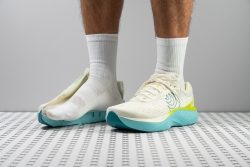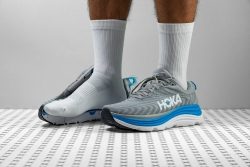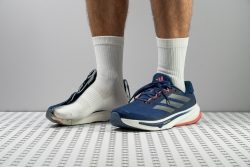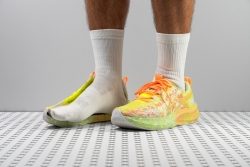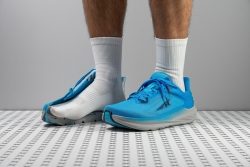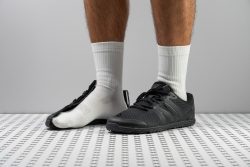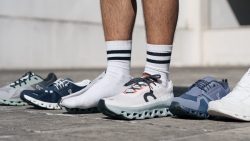7 Best Running Shoes With A Wide Toebox in 2025
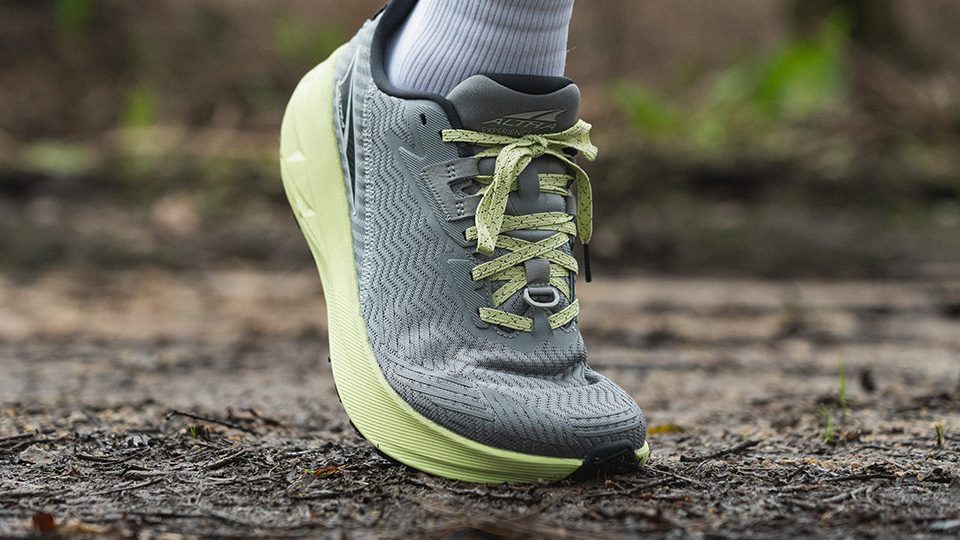
We buy shoes ourselves. We earn commissions when you buy through us, at no extra cost. Why trust us
Runners with wide toeboxes may struggle to find a good fit. We've all been there - hearing about a shoe, reading about it, learning it's all you want and need, plus the price is great. Then you try the shoe on, and it cramps your toes. To put an end to this, we started measuring exact toebox widths in our lab.
Often, Altra, Xero, or Topo feature the wide toebox, but thanks to our lab measurements, you can find other brands that happen to deliver more room in the toebox!
Based on our test runs and lab tests, we picked the best running shoes with a wide toebox across different categories. You can read our arguments why we think those shoes deserve all the spotlight, or, you can read our guide where we dig deep and explain everything about toebox width.
How we test running shoes with a wide toebox
We tested running shoes with a wide toebox both in our lab and on the test runs. For a pair to end up as a top pick, it had to go through the same procedure as any other running shoe we tested. Here's how we do it:
- We buy all the running shoes with wide toeboxes with our own money. This is to make sure we remain bias-free and transparent.
- Equipped with the necessary tools of the trade (scales, durometers, callipers, smoke machines, etc.), we cut each model into pieces in the lab. We then measure and analyse 20+ parameters of the shoe. This way, the data backs up our first-hand experience.
- We wear each pair on test runs.
- Based on our test runs and lab tests, we publish in-depth reviews. These reviews feature all the lab data and you can compare the shoe of your interest to other shoes or to the category averages.
- We showcase the best of the best here as top picks!
Best running shoes with a wide toe box overall
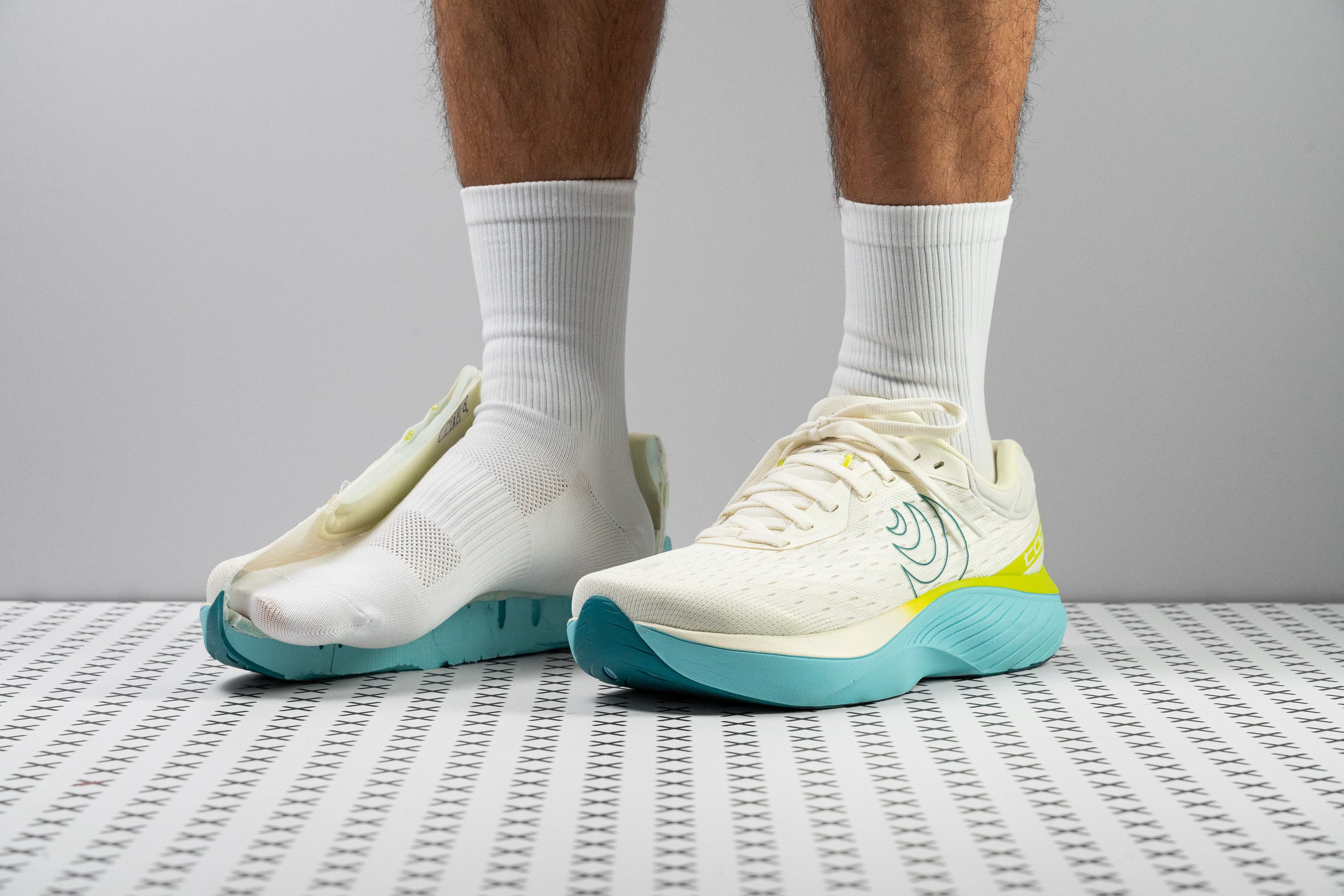

















































What makes it the best?
High-stacked with a secure sensation without the toe pressure is how we can perfectly describe our runs with the Topo Atmos. Our lab results validate its excellent impact protection through maximum cushioning while ensuring stability through its rigid build and wide dimensions. Overall, it’s our top wide-toebox running shoe.
Topo Atmos is designed to accommodate wide feet, which is evident in its shape. To confirm further, we created a gel mould to measure the toebox, and it emerged an impressively spacious 85.0 mm in the big toe area. For reference, the average big toe area is 3.0 mm narrower. Together with its generous height, Atmos is suitable for those with wide, high-volume, or square-shaped feet.
Besides the front, the whole base is wide at 119.1/96.8 mm! We felt sure of each stride because our feet stayed contained in the shoe. Its high level of stiffness also contributed to its stable feel, validated by its 5/5 torsional rigidity score in our manual assessment.
Comfort is enhanced through its extra thick 37.8/32.5 mm cushion, delivering impact protection for multi-hour runs. It feels balanced underfoot with a 20.0 HA durometer reading without the sinking feeling. However, its energy return is underwhelming. Those seeking a responsive ride should stay away from Topo Atmos.
Pros
- Max-cushioned comfort
- Ultra-spacious toebox
- Stable ride
- Premium Ortholite footbed
- Midfoot-friendly geometry
- Lightweight for its huge size
- Great for easy long runs
- No heel slippage
Cons
- Lacks energy return
- Not for narrow-footed runners
- Could be a bit more flexible
- Not the best for walking
Best stability running shoes with a wide toebox
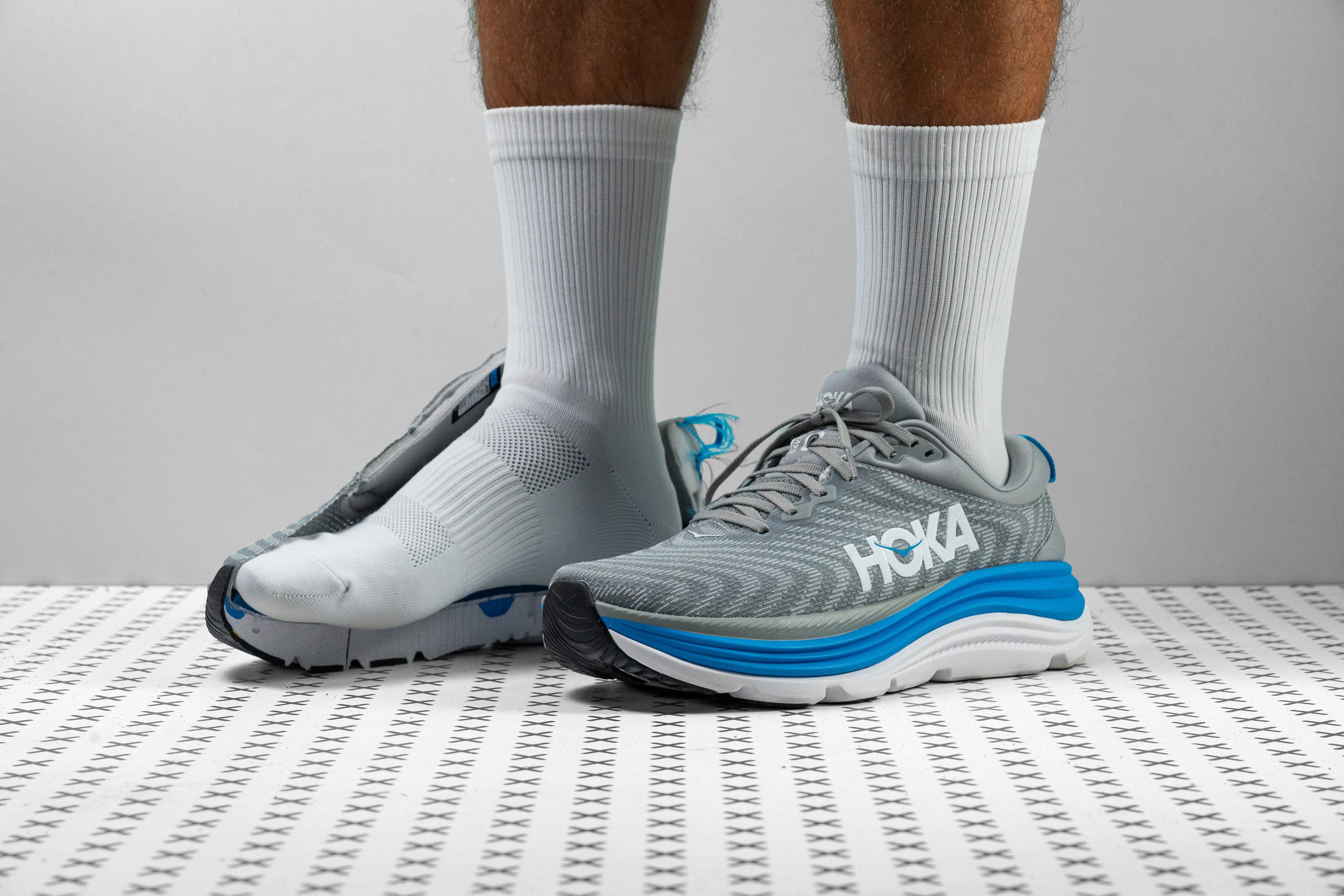


















































What makes it the best?
No room for toe stubbing and wobbling in the Hoka Gaviota 5, as it offers the best stability among wide toebox running shoes we tested on foot and in the lab. Besides its broad dimensions, it features the rigid H-Frame that offers solid support, while its cushioned base and breathable upper appeal us with comfort.
Offering generous space for wide-footed folks, the base is a massive 125.1/106.6 mm. Besides enhancing comfort, it secures our strides because our feet remain contained within the shoe. On top of this, the H-Frame’s rigidity helps avoid excessive lateral movements and ankle rolls, evidenced by its 4/5 torsional rigidity score.
Moving to the toebox, it barely tapers to its 77.2 mm big toe area. For reference, the average is pointier at 73.7 mm. This spacious room allows for natural toe splay and is kind enough even to those with big or pointy toes. Plus, the upper is exceptionally breathable, backed up by its 5/5 breathability score in the lab.
Underfoot, a dual-density midsole welcomes us with a plush 12.9 HA cushion for comfort and a firmer 22.0 HA foam in strategic areas for stable landings. However, it features a low 2.2 mm drop, which may not suit heel strikers. Midfoot and forefoot strikers will feel more at home with this minimal incline setup.
Pros
- Remarkably stable
- Breathable and comfortable upper
- Lightweight for its size
- Good stability option for forefoot strikers
- Ideal for wide feet
- Excellent for long runs
- Excellent for long runs
Cons
- Low drop might pose issues for heel strikers
- Performs poorly in colder conditions
- Not for narrow feet
- Midsole feels flat
Running shoes with a wide toebox with the best energy return
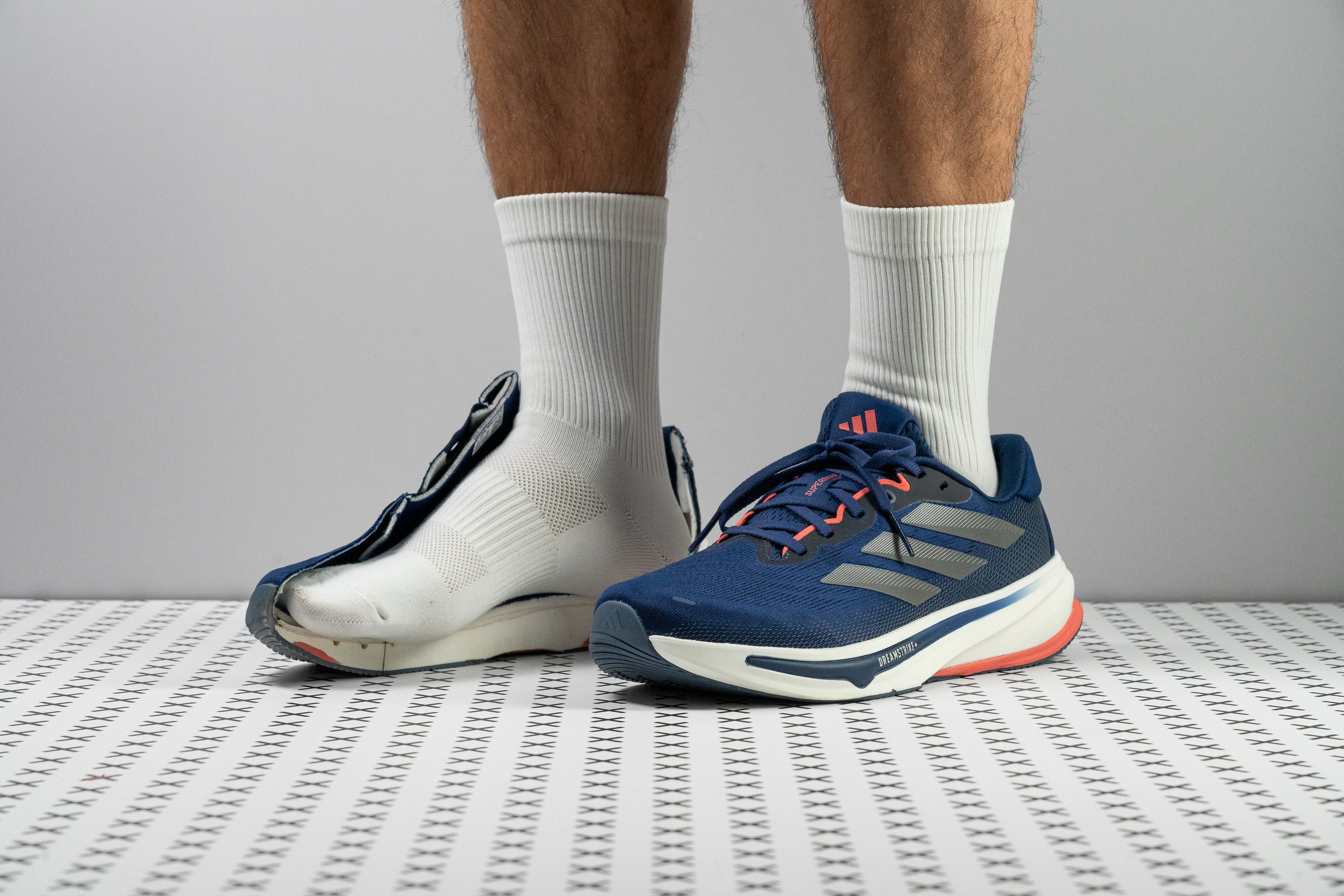

















































What makes it the best?
The Adidas Supernova Rise 2 manages to maintain a slim profile and low weight despite its very accommodating toebox. Its streamlined build and fluid midsole impressed us greatly in the lab, delivering a highly agile, ground-connected, and responsive ride, making it our ultimate wide toebox running shoe with the best energy return.
We had zero hesitations to speed through our runs because the midsole could keep up, with respective above-average energy return scores of 69.5% and 68.1% in the heel and forefoot. It features a moderate 33.5/24.0 mm stack with high surface sensitivity that allows us to adapt, validated by its low 96 SA shock absorption score in the forefoot.
At just 9.1 oz (257g), SR2 is slightly lighter than the 9.3 oz (265g) running shoe but feels more weightless due to its otherworldly flexibility. In our bend test, it emerged remarkably 51.3% more flexible than average.
Our feet had a lot of breathing room despite the narrow midsole, thanks to the toebox that follows our natural foot shape. Our gel mould is a wide 98.7 mm and barely tapers to the 77.7 mm toebox.
However, its heel is quite narrow at 86.0 mm, making the ride unstable for some runners. We recommend extreme heel strikers to find alternatives for better comfort and surefootedness.
Pros
- Lighter than version 1
- Comfortable yet breathable upper
- Cold-proof PEBA midsole
- Stable ride with Support Rods
- Reflective accents for night visibility
- Maintains competitive price tag
- Responsive Dreamstrike+ foam
- Flexible, natural running experience
- Great for walking
Cons
- Outsole lacks Continental
- Not cushioned for forefoot strikers
- Still lacks a gusseted tongue
Running shoes with a wide toebox with the best traction
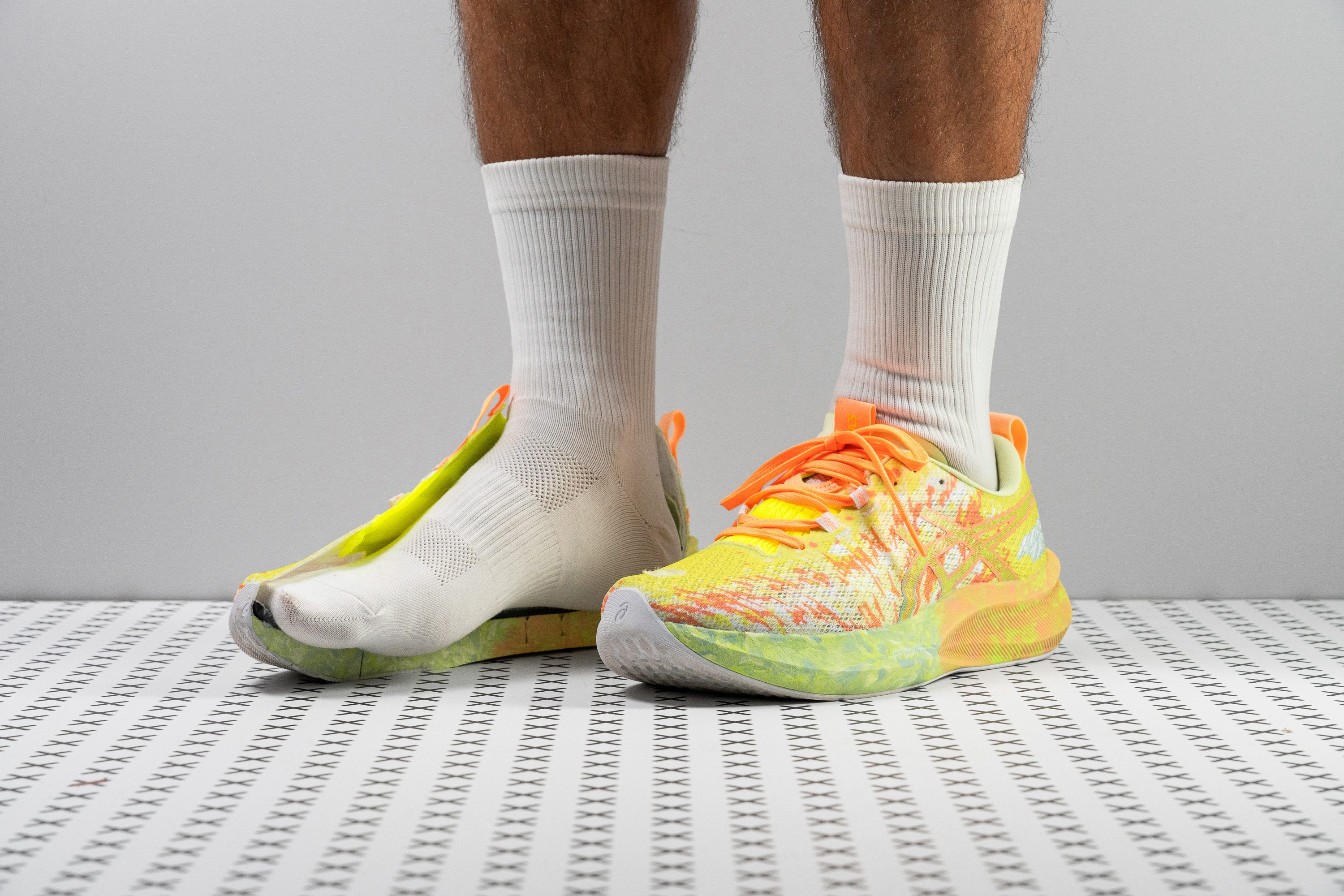























































What makes it the best?
If there’s one word we can describe the feeling of running with the ASICS Noosa Tri 16, we’d pick effortless. Its relaxed fit and loose midsole come in a lightweight package, while its next-level grip, which we proved in the lab, allows us to burn the miles mindlessly, rain or shine. Among the toebox running shoes we ran with, it offers superior traction.
To put it in figures, Noosa Tri 16 recorded a high 0.79 friction score in our traction test. One of the highest we’ve seen, it emerged a massive 71.7% grippier than average! At this rate, its strong bite keeps us surefooted even on the most slippery surfaces.
Its toebox felt very spacious, with no pressure points even during long hours of running. We created a gel mould to accurately measure the toebox, and got an impressive width of 77.3 mm. Not only that, even those with high-volume feet have lots of vertical clearance at 31.2 mm.
Despite its generous dimensions, it surprisingly maintains a light 7.7 oz (217g) figure. Being 18.1% below average, it feels easy to manoeuvre the shoe. Its flexible build delivers a smooth and refreshing ride, proven by our bend test, when it only needed 14.6N to reach 30 degrees.
However, it doesn’t offer the most explosive ride, especially for heel-strikers, with its below-average score. Performance-focused runners may want to step it up with another pair.
Pros
- Lightweight
- Exceptional grip
- Attention-grabbing aesthetic
- Gusseted tongue
- Comfortable upper
- Great for triathlon
- Really versatile
- Fantastic price point
- Breathability
Cons
- Upper longevity
- Minimal tongue padding
- Still not enough energy return
Best zero drop running shoes with a wide toebox
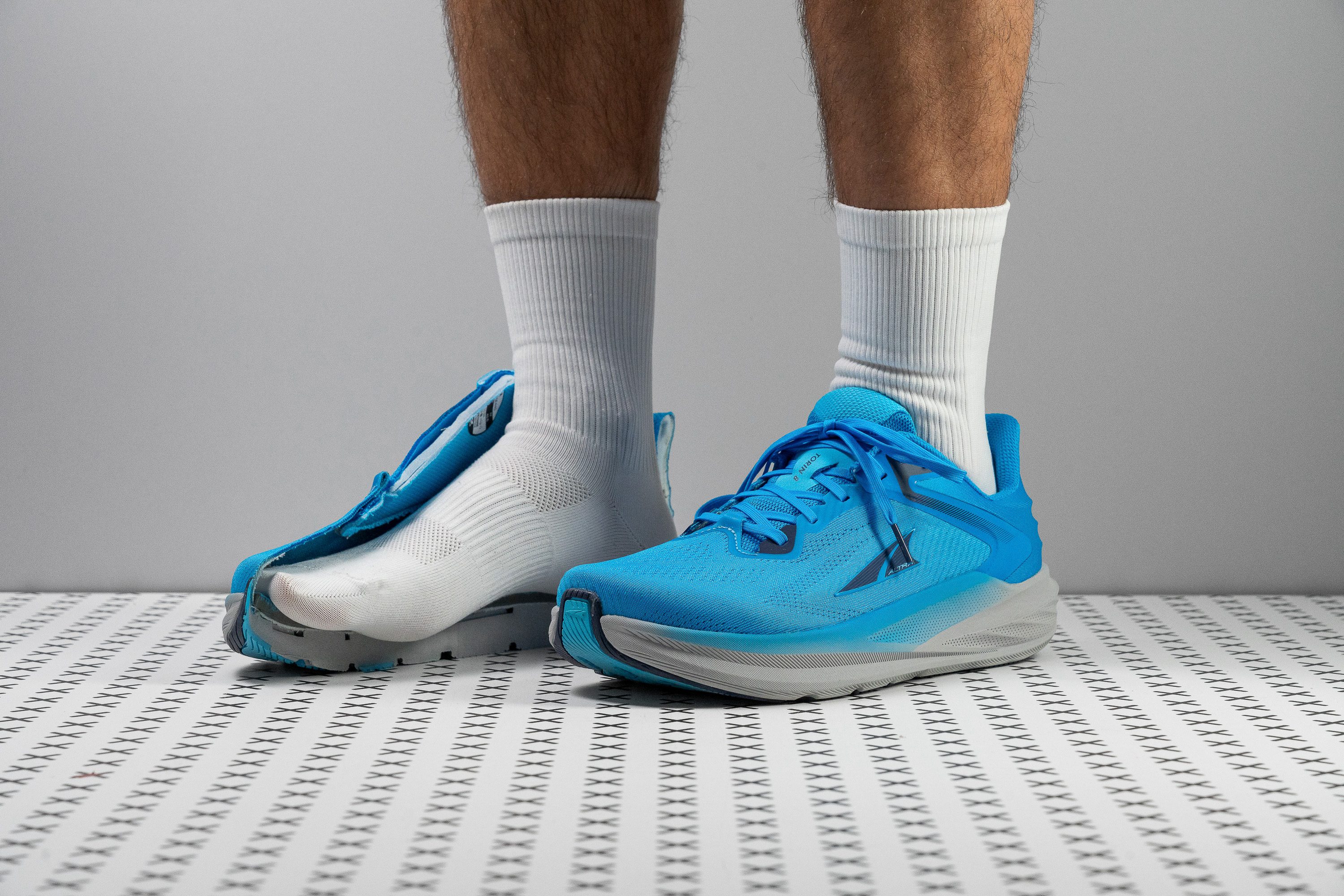

















































What makes it the best?
The Altra Torin 8 delivers a stable and grounded ride through its low platform, low incline, and low shock absorption. It offers immense ground feedback that allows us to adapt to various surfaces quickly, further enhanced by its accommodating fit that allows natural toe splay. Among the wide-toebox running shoes we’ve tested, Torin 8 is our top zero-drop trainer.
We felt like we were barefoot on the flat platform, which our calliper validates with a virtually non-existent -0.1 mm drop. The low incline naturally delivers a steady feel while the broad 117.7 mm forefoot further secures our foot alignment.
Torin 8 has a low profile, 27.6/27.7 mm to be exact, which enhances the natural and well-planted feel of the shoes. We measured a low shock absorption score of 110 SA in the heel, which means it offers better ground connection than average, perfect for manoeuvring through uneven trails.
Our toes never felt restricted because of the massive 83.6 mm toebox of the gel mould replica. It’s less pointy compared to the 73.5 mm average measurement in the lab and effectively avoids black toenails and calluses.
With its minimalist padding, we expected a lower weight. Disappointingly, Torin 8 is heavier than average at 9.7 oz (275g).
Pros
- True zero-drop midsole
- Foot-shaped, wide toebox
- Excellent durability
- Improved heel lockdown
- Plush step-in comfort
- Keeps the same price
- Can be used for walking
- Amazing for forefoot strikers
- Improved outsole
- Stable
Cons
- Weight gain compared to v7
- Not for rearfoot strikers
- Needs a better foam ASAP
- Non-gusseted tongue
Best minimalist running shoes with a wide toebox
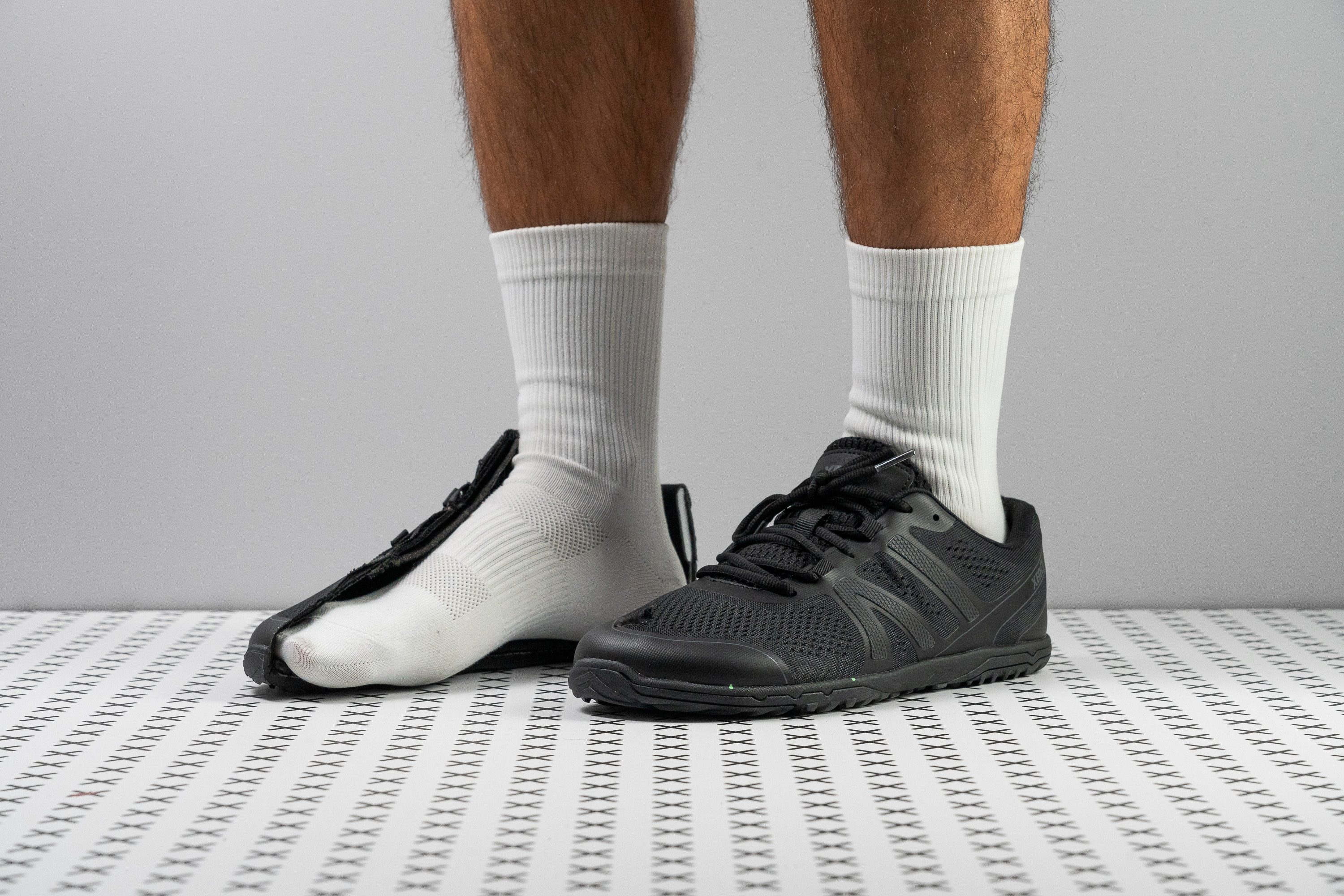







































What makes it the best?
Our feet can attest to Xero Shoes HFS II’s exceptional ground feel and straightforward build. Our lab results confirm it’s a barefoot wonder with its low platform, zero drop, flexibility, and spacious design, making it our best minimalist wide toebox running shoe.
HFS II ensured maximum surface feedback with its minimum cushioning, with precise calliper measurements of 13.1/12.1 mm. This configuration results in a 1.0 mm drop that feels flat—like we don’t have any shoes on. This setup strengthens our leg muscles since we have to do the work.
HFS refers to “Highly Flexible Shoe” and this shoe proves it’s perfectly named, emerging 62.6% more adaptive than average in our bend test. It offered no resistance whatsoever which allows us to freely move, enhancing the barefoot sensation.
The toebox is designed to be forgiving, making even our pinky toes feel at home. Using our gel mould, we measured the big toe area at 86.7 mm, 10.6% wider than average, effectively avoiding cramped toes or unwanted pressure points.
However, what’s not minimal is its 8.6 oz (244g) weight. While this is lighter than average, we expected it to be much lighter because of its simple and humble construction.
Pros
- Anatomical toebox for natural toe splay
- Real minimalist design
- Reasonably priced
- Versatile for roads and light trails
- Amazing at gym workouts
- Ultra-flexible and easy to pack
- Full-length outsole coverage
- Superior ground feel
- Promotes feet strength
Cons
- Midsole lacks energy return
- Heavier than most minimalist shoes
- Durability still needs improvements
Best lightweight running shoes with a wide toebox
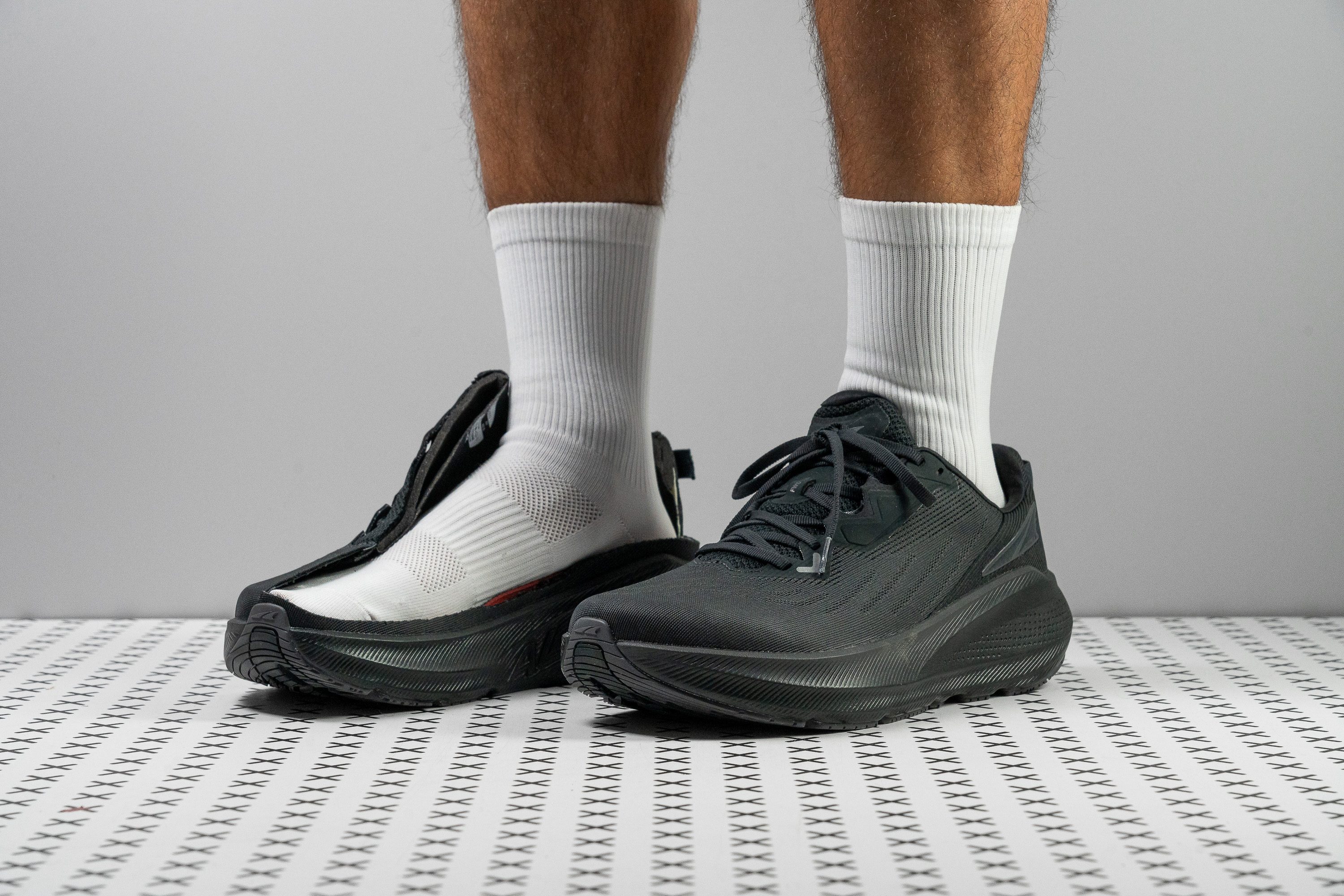











































What makes it the best?
During our runs in the Altra FWD VIA, we can’t help but think it’s crafted for comfort. In the lab, we verified its ultra-roomy fit, manoeuvrable midsole, and cushioned forefoot without tipping the scales, making it our best lightweight wide-toebox running shoe.
For its size, we were impressed to see its low 9.0 oz (255g) build. Its airy sensation is further enhanced by the flexible midsole, which only needed 14.5N to reach 30 degrees in our bend test. It’s easy on the feet and a reliable choice for everyday wear.
FWD VIA features the FootShape design, which gives us lots of wiggle room during our runs. To be more precise, we created a gel mould to measure the shoe’s interiors. The toebox is massive at 84.5 mm, 11.0 mm wider than average! Together with its 29.1 mm vertical clearance, all five toes could rest inside the shoe comfortably.
The midsole offers lasting comfort, particularly for midfoot and forefoot strikers, because of the thick 29.4 mm forefoot stack we recorded. It also impressed with 7.6% higher shock absorption than average, leading to a well-cushioned experience.
Note that FWD VIA has a 6.5 mm drop. While this makes it more accommodating to heel-strikers, it may disappoint Altra fans seeking a low or zero-drop trainer.
Pros
- Exceptionally spacious toebox
- Lightweight considering its size
- Reliable traction
- Most heel-striker-friendly Altra so far
- Plush step-in feel
- Semi-gusseted tongue
- Stable landings
Cons
- Underwhelming energy return
- Midsole feels firmer than expected
- Durability could be better
- Actual drop differs from stated spec
This guide focuses on a wide toebox in running shoes. If what you actually want is wide running shoes overall, and not just a wide toebox, head over to Best running shoes for wide feet.
Unlike the overall shoe width, the toebox has no industry labels or standardised widths and brand measurements. It can be a cat in the bag if you're ordering the shoes online until you find our reviews that list exact lab measurements of the toebox width.
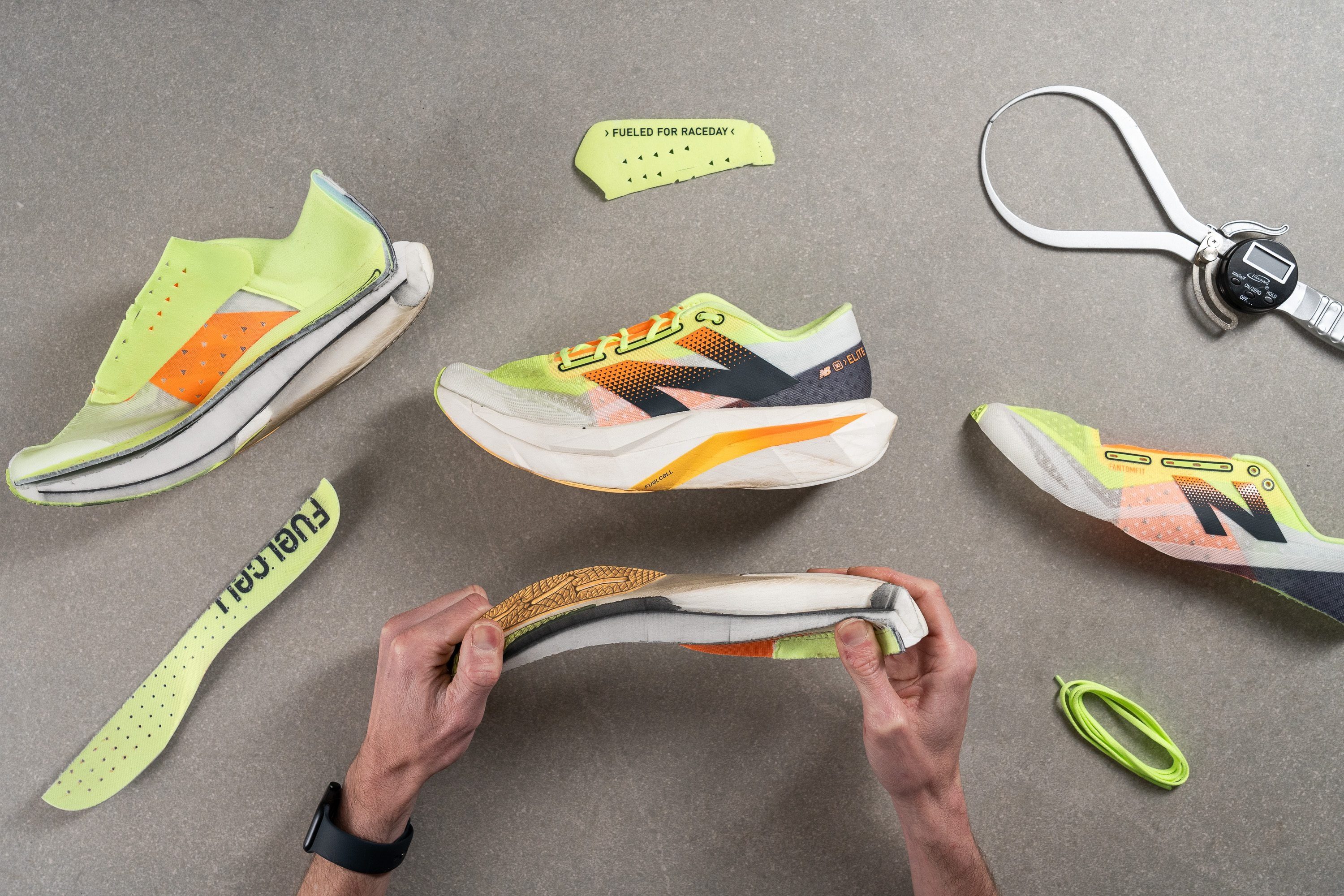
Do you really need a wide toebox?
If you've experienced any of these, then you most likely do need running shoes with a wide toebox:
- Your toes are often cramped in the toebox
- Your pinky toe wants to "escape" the toebox and it often pokes a hole through the upper, it blisters, or it makes the next toe bleed because pinky toe presses against it too hard
- You have bunions or bunionettes
- You must wear the thinnest socks only because anything thicker makes the toebox too tight.
Some runners also do this as a test: they take the insole out of the shoe and check whether their toes hang over the insole. If they do, a wider toebox is needed.
| If you keep running in narrower shoes while your toes are screaming for more room, you may experience black or ingrown toenails, painful corns and calluses, blisters, or bunions. |

Toebox width: lab data
Lasers and callipers that we could use to measure the width of the shoe can't fit into the shoe, especially the toebox. If we cut the shoe in half or into pieces, the upper loses its structure, making it impossible to assess or measure its width accurately. So, we use gels.
When we take the gel mould out of the shoe, we measure the width of the shoe in 2 places, at the big toe and where it's the widest (around the ball of the foot).
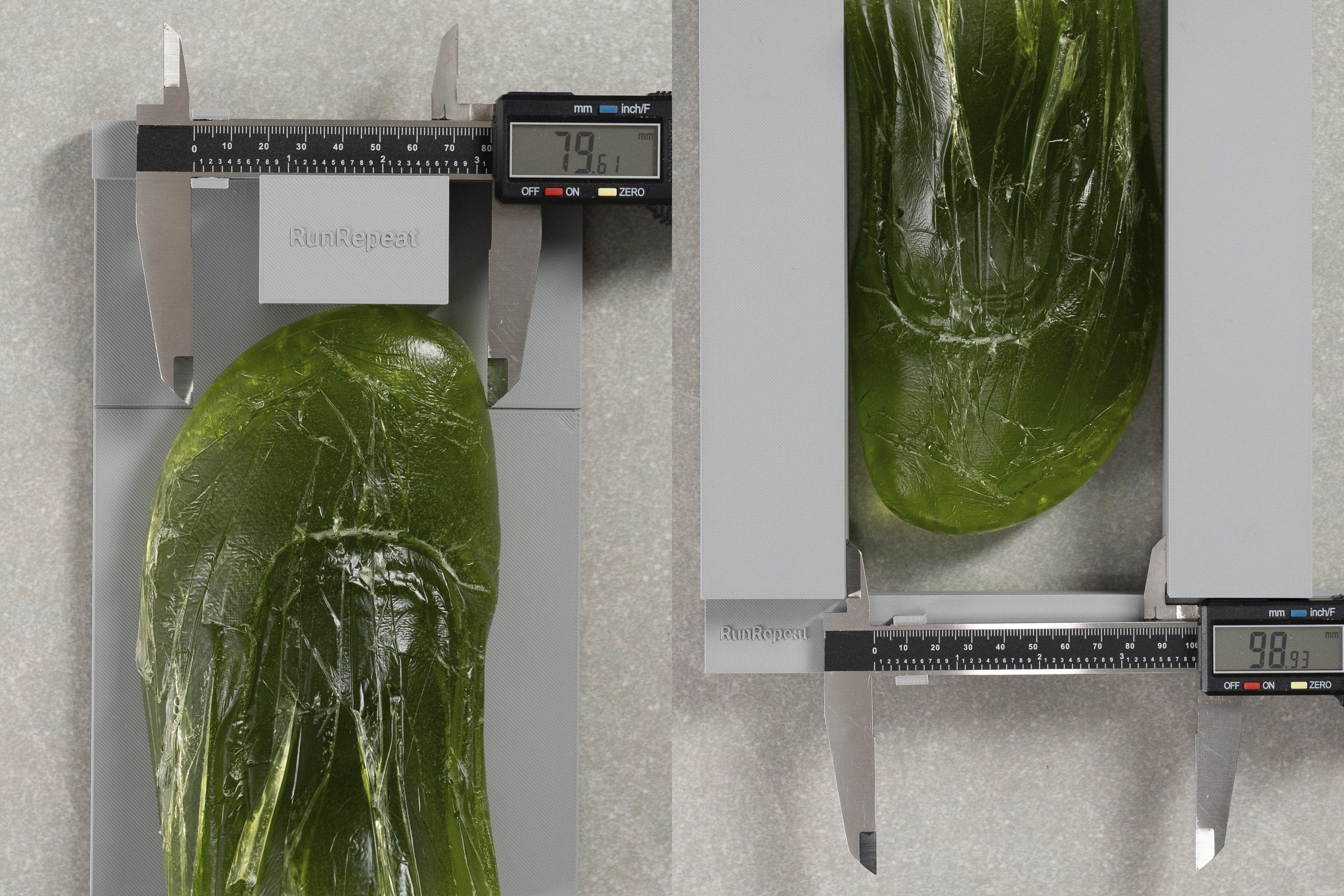
The toebox width tells us how wide it is in the place where runners usually need more room when they say they are looking for a wide toebox.
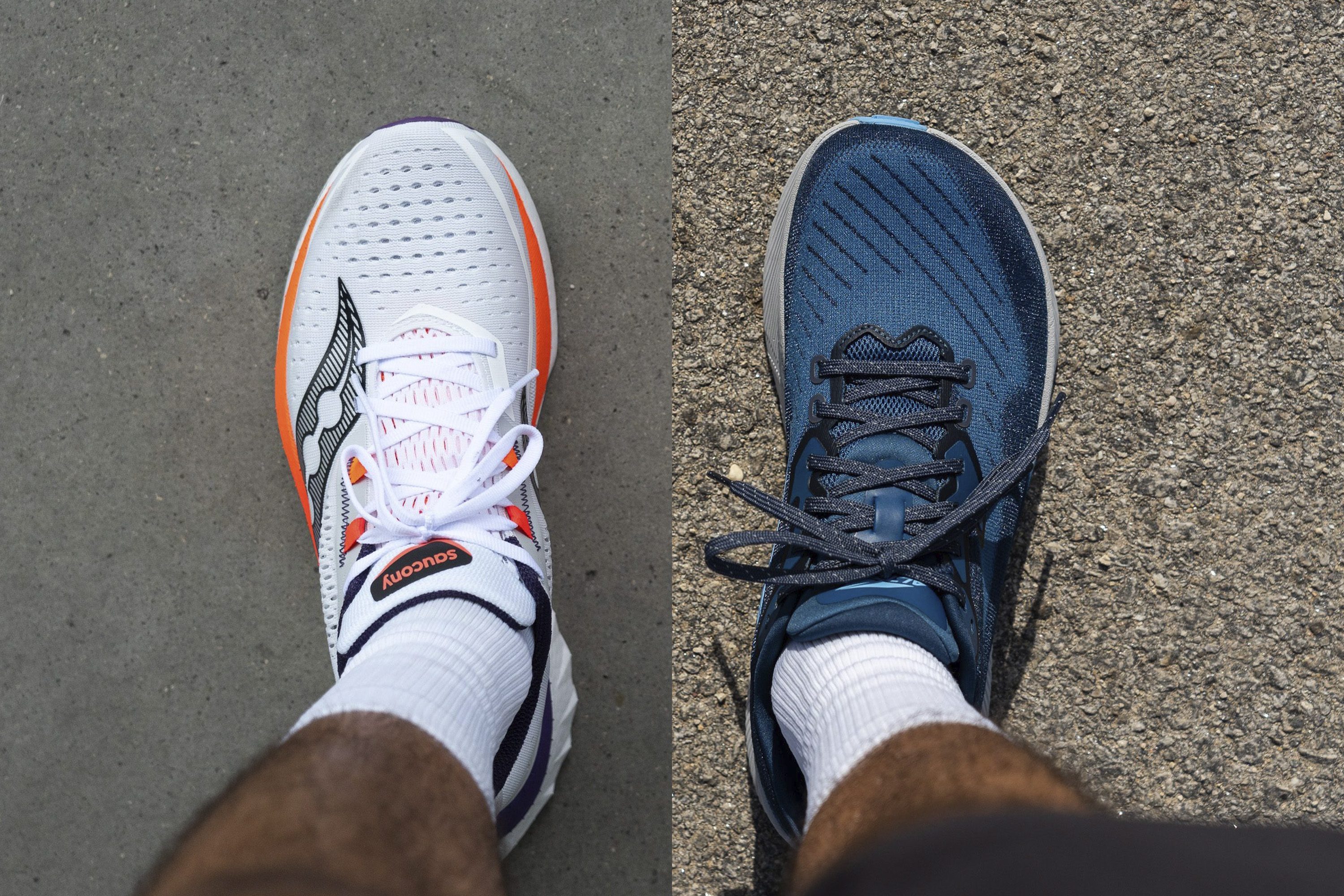
Here's how such a difference (tapered or pointy vs rounded) looks when we look at the gel moulds:
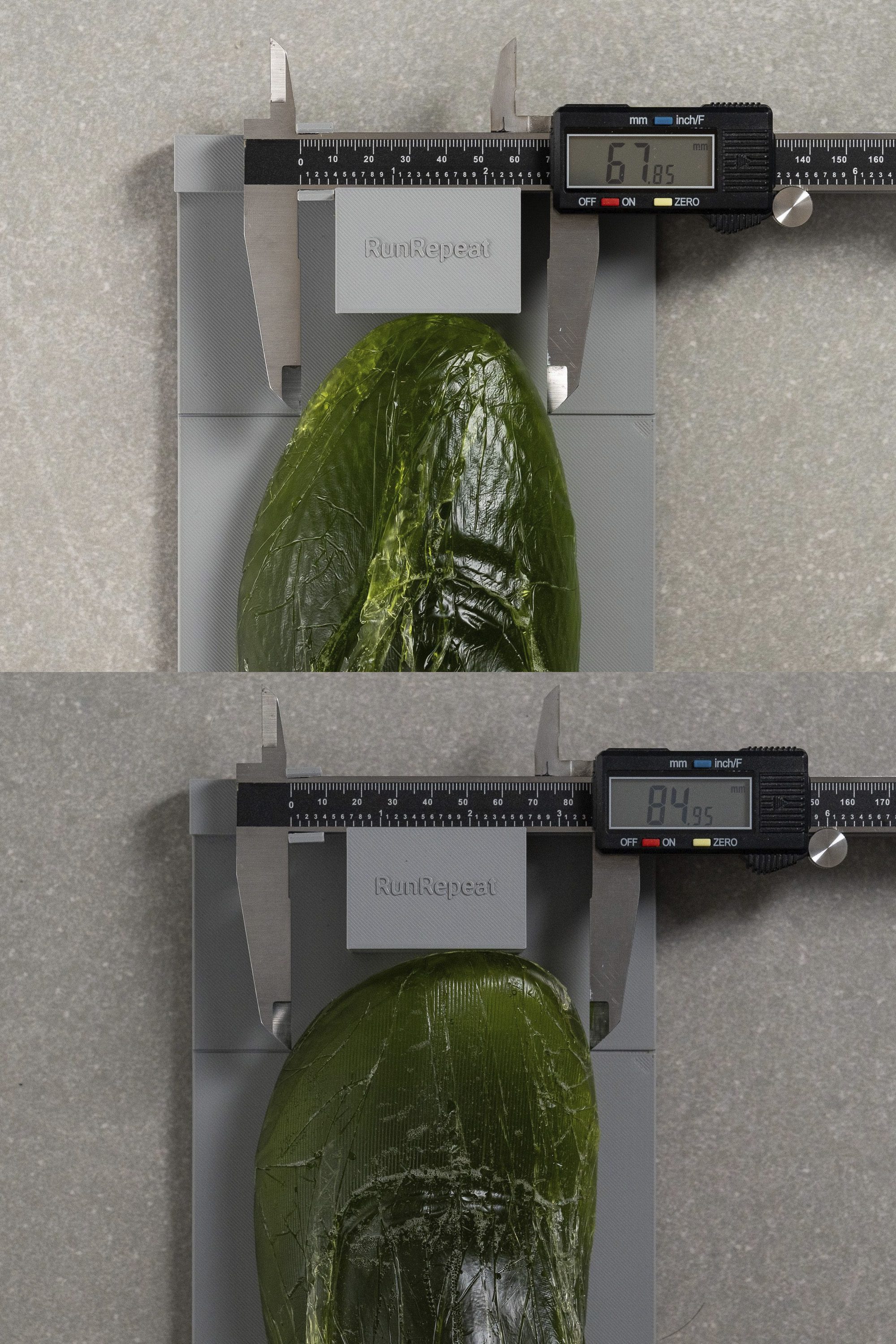
The other measurement, the toebox width measured where it's the widest, reflects the overall shoe width. While it matters, of course, it matters much less than the big-toe width when we talk about how roomy a toebox is. We talk about this in great detail in our guide Best running shoes for wide feet.
Toebox height: a hidden gem no more
Some runners may say they need a roomy toebox because they keep feeling pressure on their toes or even getting black toenails. When the upper presses on the toes from above, it's about the need to have a higher toebox.
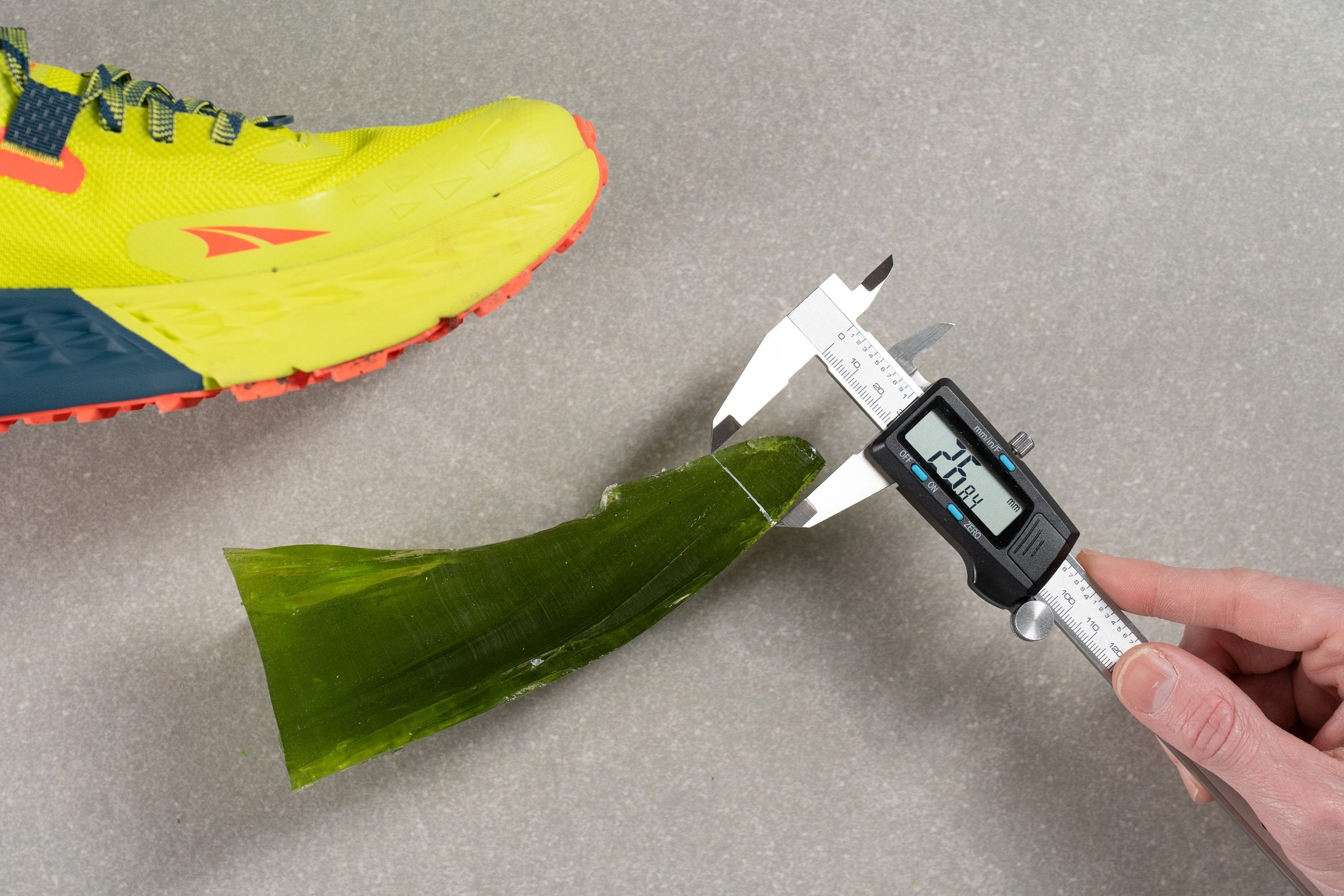
Runners whose big toes are pointing up, whose toes can’t wait to hit the toebox ceiling and maybe even try to dig through it, can now look at the lab data and see how much vertical room each toebox has to offer.
If the upper material is soft, sooner or later, a hole appears. Big toe breaks free. If the material is stiff, harsh, or maybe it has protective overlays in that spot, we’re talking about blisters, bleeding, and black toenails. To start with.
Here's what that difference between a high and a low toebox looks like when we look at shoes cut in half:
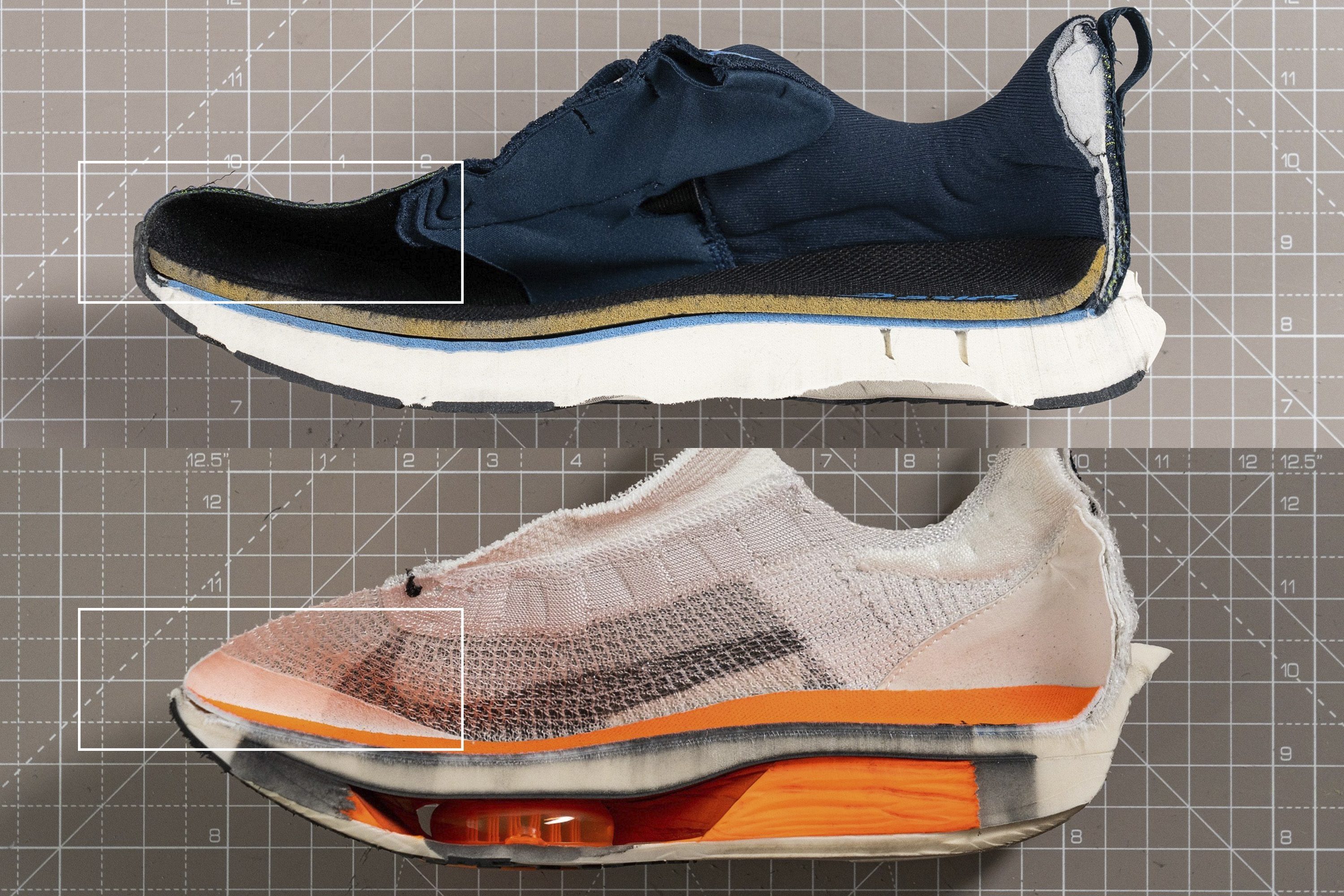
And here's what it looks like when we look at the gel moulds:
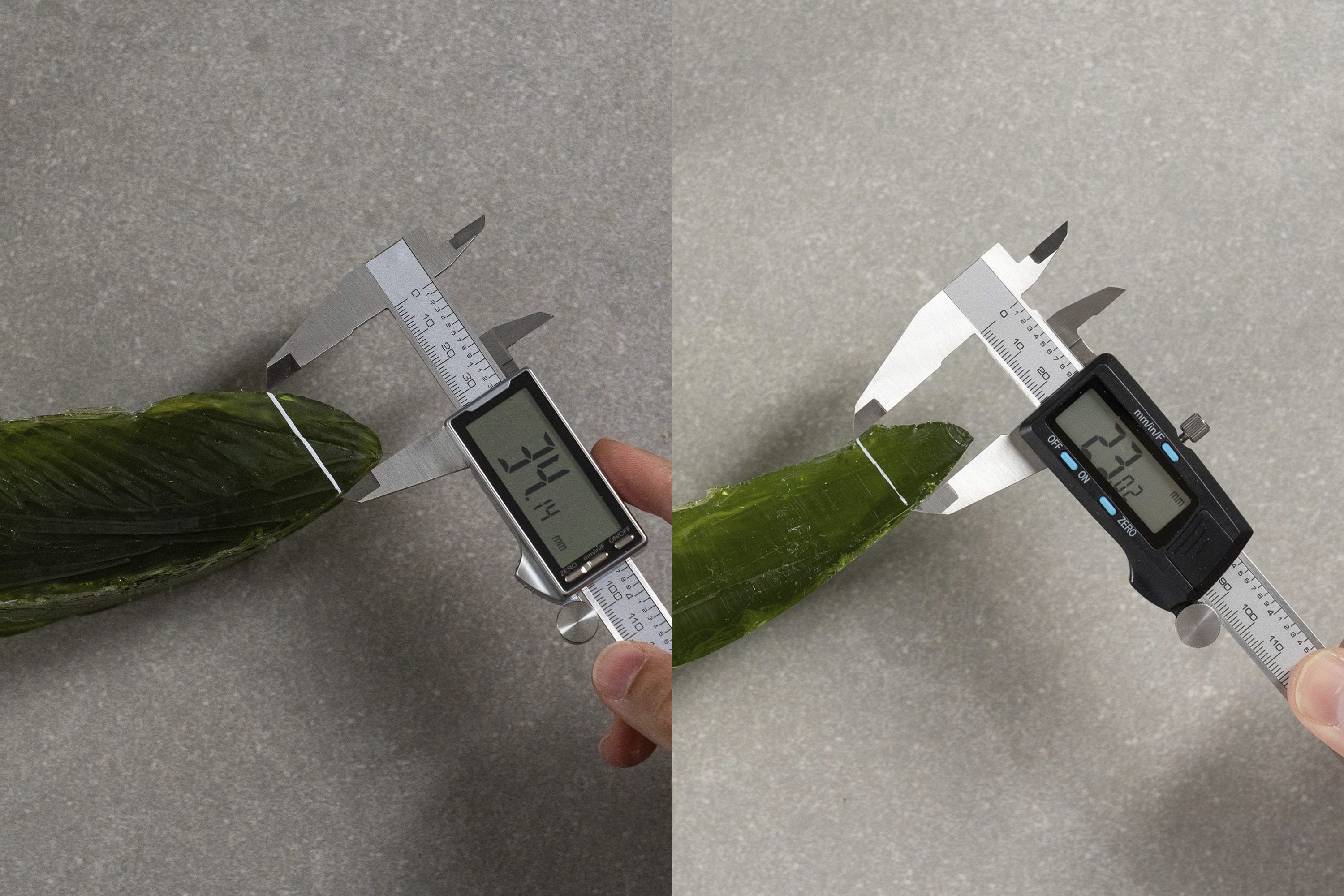
Foot-shaped toebox: should you go for it?
In short, if you have a wide forefoot and you love it when your toes have enough room to splay, you could give it a try.

However, the so-called foot-shaped toebox is a trademarked shape from Altra, and all Altra shoes are zero-drop or low-drop (heel drop of 4 mm).

For context, beginners are advised to use running shoes with an 8-12 mm drop. Changing the drop suddenly, and especially going for the 0 mm or 4 mm when you’ve never done it before, is not something we recommend. This transition is definitely possible, but it should be slow and gradual! We wrote about this and covered many details in the Ultimate guide on the heel drop.
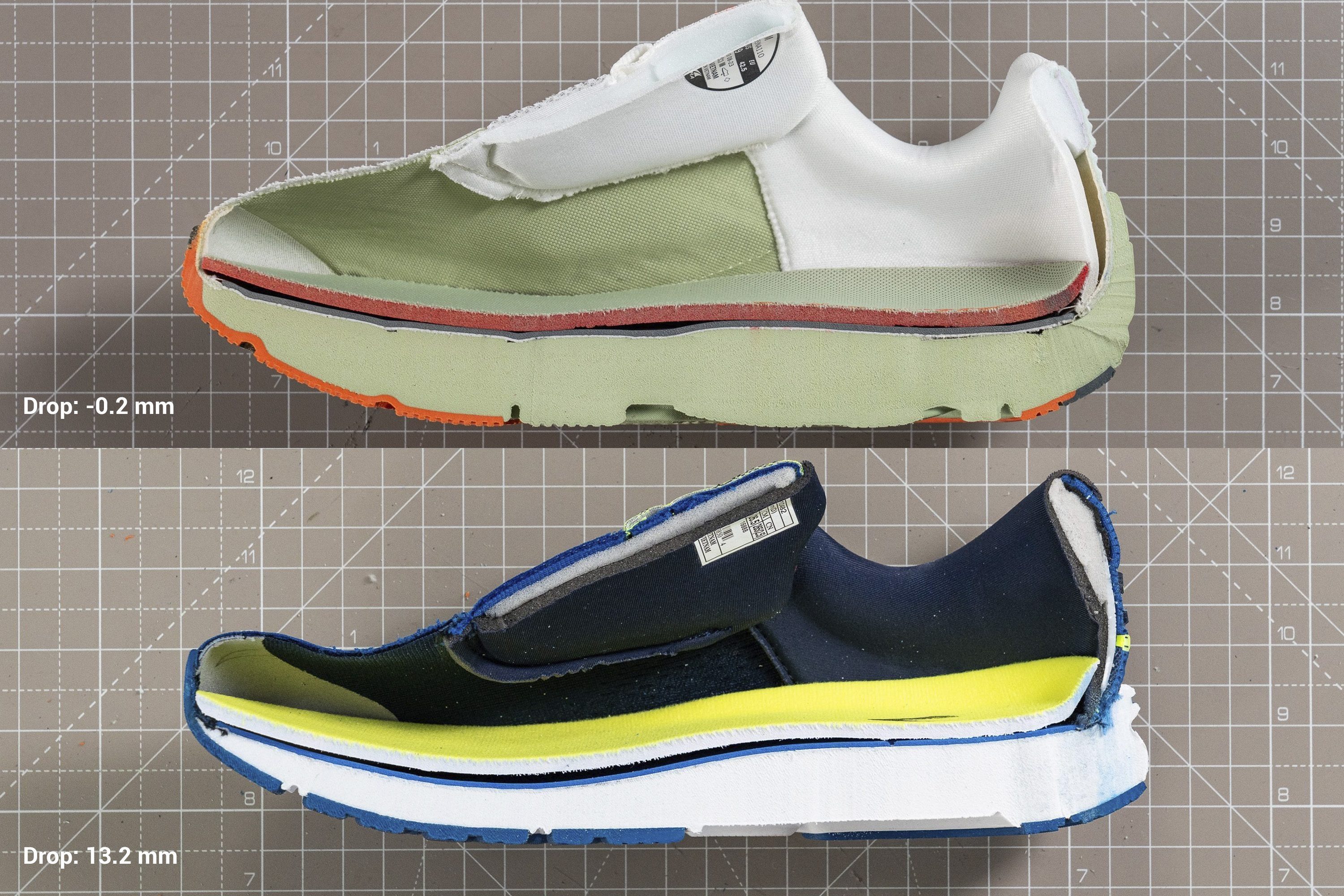
Although it’s called foot-shaped, there isn’t only one such shape made by the Altra, there are actually 3: original, standard, and slim. What’s great is that they are all on the wider end. We went down the rabbit hole and looked at the numbers for different Altra models in our guide on Best Altra running shoes. The only caution here is related to the heel drop, as explained above.
Is your toebox too wide?
Your toebox is too wide if you can feel sliding from side to side in it, if you can't achieve a secure lockdown, if you feel insecure the moment the terrain varies even slightly, or, simply, if your toes can splay and it's a very roomy feel in there.
Shock absorption and energy return of running shoes with a wide toebox
Many running shoes with a wide toebox are actually foot-shaped, minimalist, or barefoot. This usually means they are not high-stacked or packed with the newest technologies. Which is why we're even more curious about their shock absorption and energy return.
We test and prioritise both because, from them, we learn a) how protective the midsole is (how good it is at dampening the impact forces), and b) how responsive it is (how good it is at bouncing back up). These 2 are insanely important because low scores lead to early muscle exhaustion because runners' legs have to work more.
We perform tests both at the heel and at the forefoot, so you look for more shock absorption exactly where you need it, depending on your foot strike.
The higher the shock absorption (in SA) and energy return (in %), the better!
Breathability of running shoes with a wide toebox
Breathability depends on the material and the overall design. The type of material is what we first notice when we hold the running shoes in our hands. Knit uppers are soft and stretchy but also less durable and less breathable. Mesh uppers offer more structure but may be harsh.
However, this is not enough for us. We then inspect the upper under the microscope.
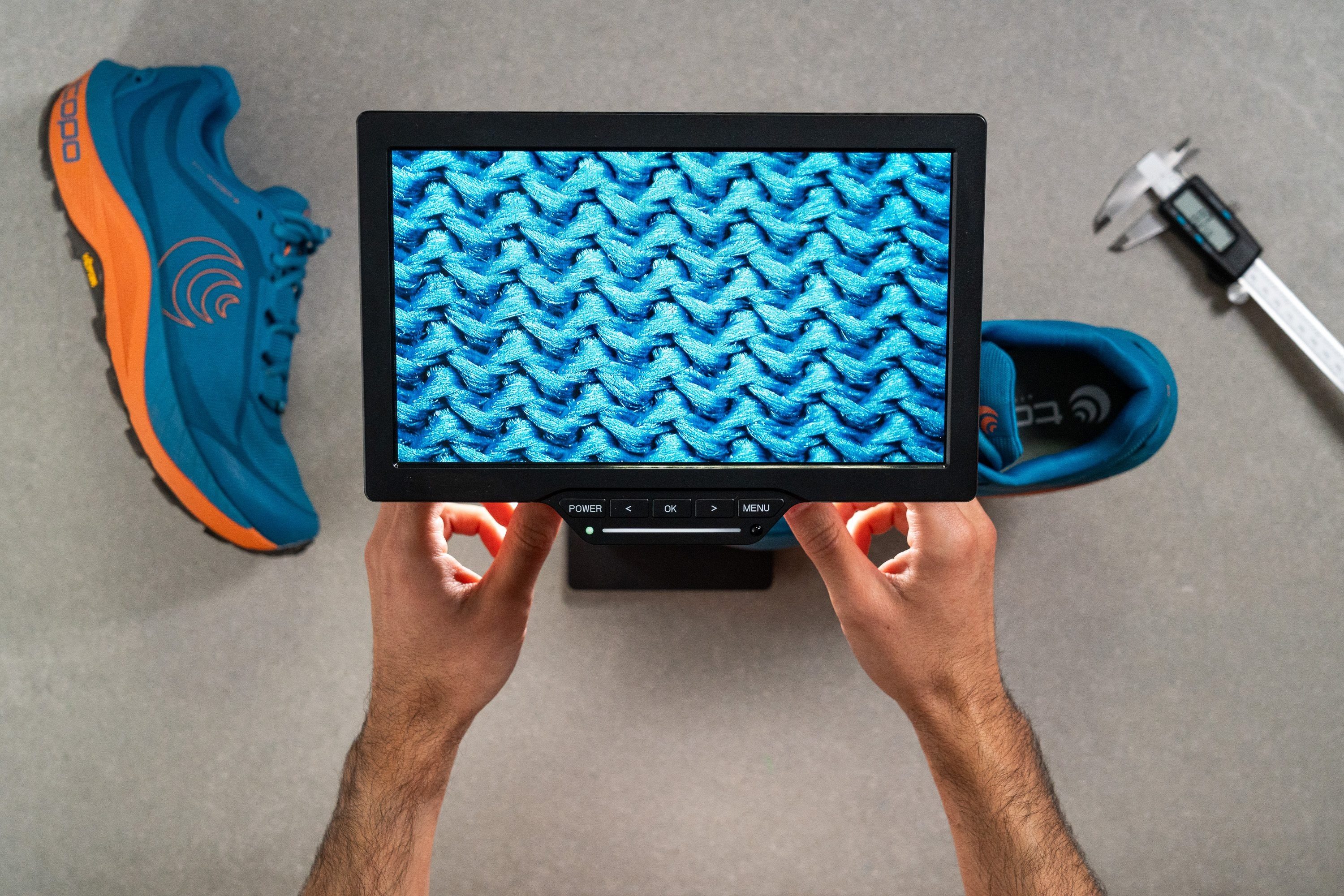
This is where we learn more about the design - are there any ventilation holes that we can see with the naked eye, is there a 2nd layer that impacts the breathability heavily, are the threads tightly packed or loose, etc?
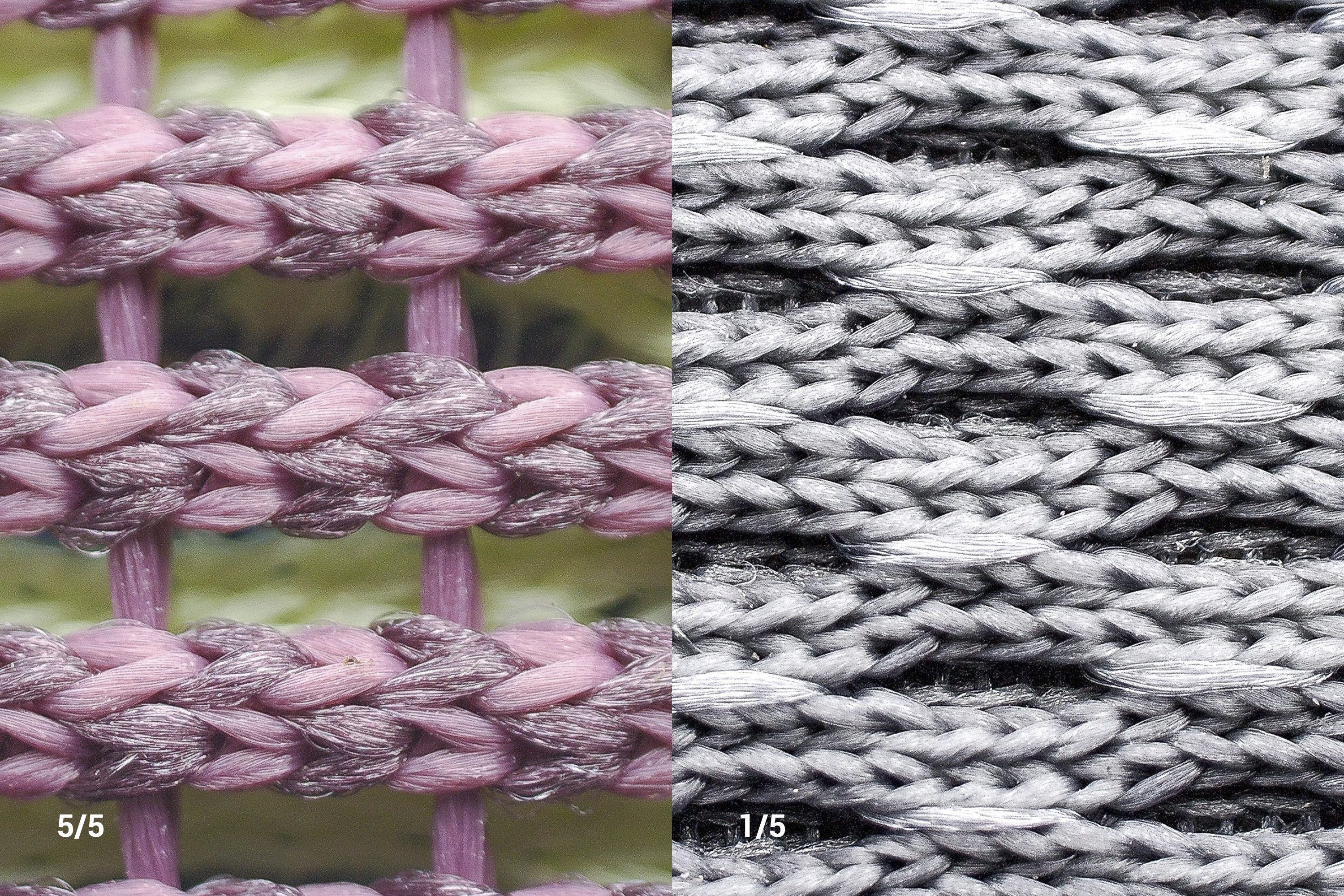
We recommend wide running shoes that scored 5/5 on our breathability test to those who have sweaty feet or who run in very warm climates.
Running in shoes that scored 1/5 or 2/5 on our smoke machine test is great for colder weather.
Everything in between, running shoes that scored 2/5, 3/5, or 4/5, can be used during all seasons, although with no extremes. You can simply adjust by picking thinner/thicker socks.
Durability of running shoes with a wide toebox
You may worry that your toes will stretch the upper too much to the point of premature breaking. Or you want to make sure other areas, like padding behind the heel or the outsole, don't die on you too soon. Awesome news, we test that in our lab!
In all of our durability lab tests, we use a Dremel. Then, we either assess the damage and assign a durability score on a 1-5 scale (5/5 being the most durable), or we measure the depth of the dent.
Knit uppers are less durable but more pliable and kinder to our toes. Mesh uppers, on the other hand, are more breathable and have more structure.
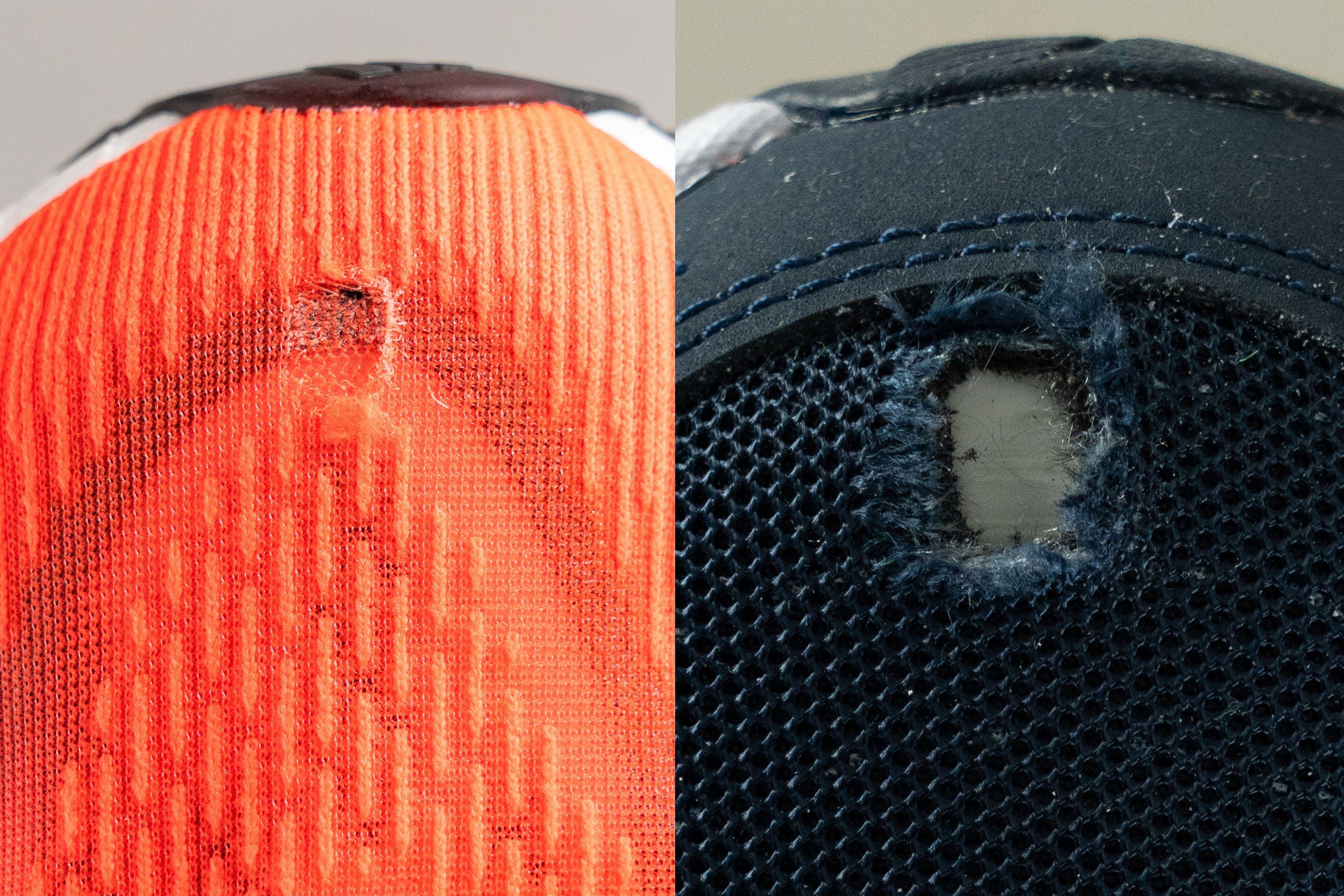
Then, we move to the heel. For many runners, it's the padding behind the heel that gets destroyed first, be it due to the way they put the shoes on, the slight heel slipping, or the shape of their heel and the shape of the shoe's heel area.
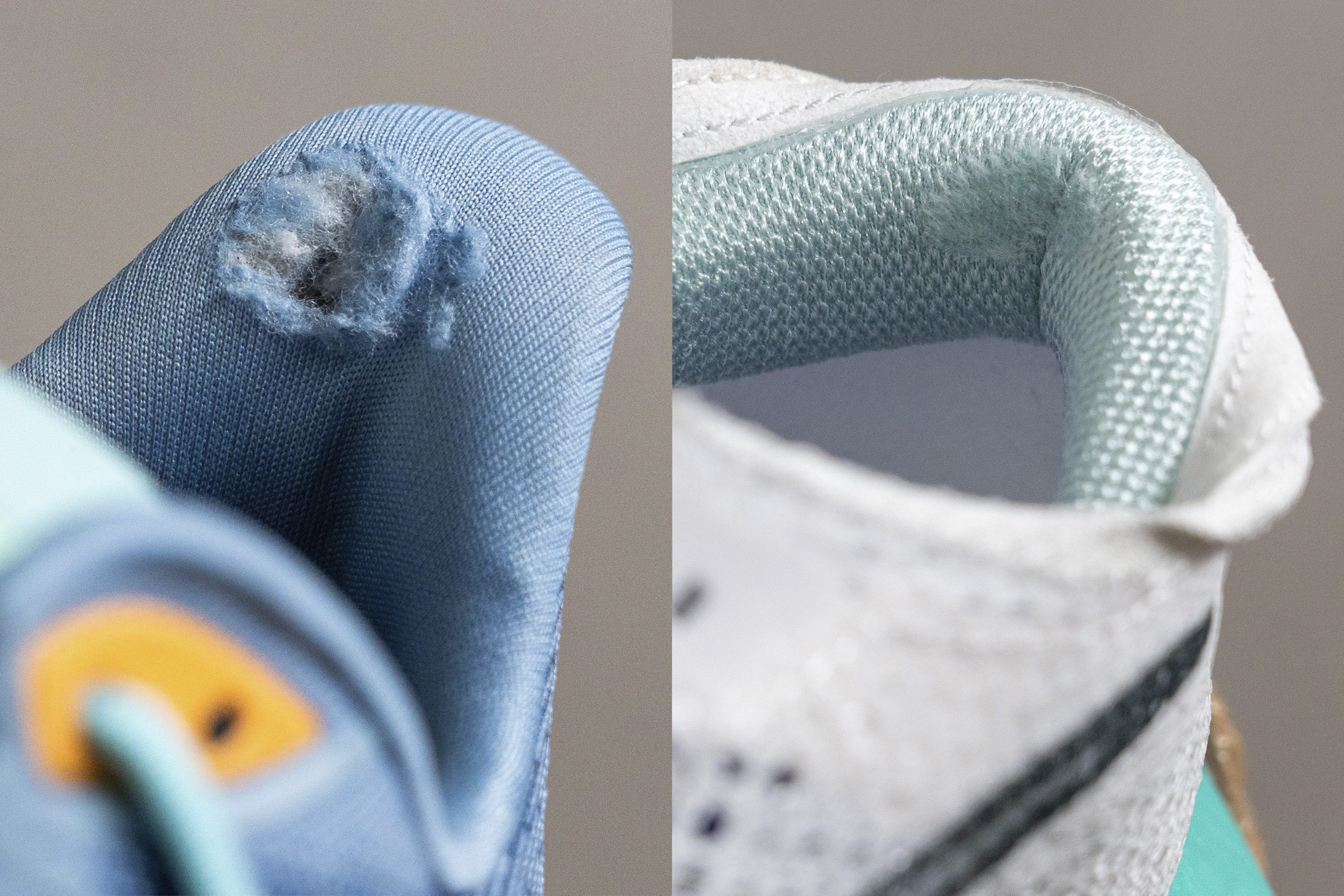
Then, we test the outsole's durability. Having rubber coverage here does wonders, such outsoles are way more durable. When greeted with the exposed midsole, our Dremel simply digs in as if it were pudding.
Here, we don't have to assess the damage on a 1-5 scale because we can use a tyre tread gauge to precisely measure the depth of each dent.
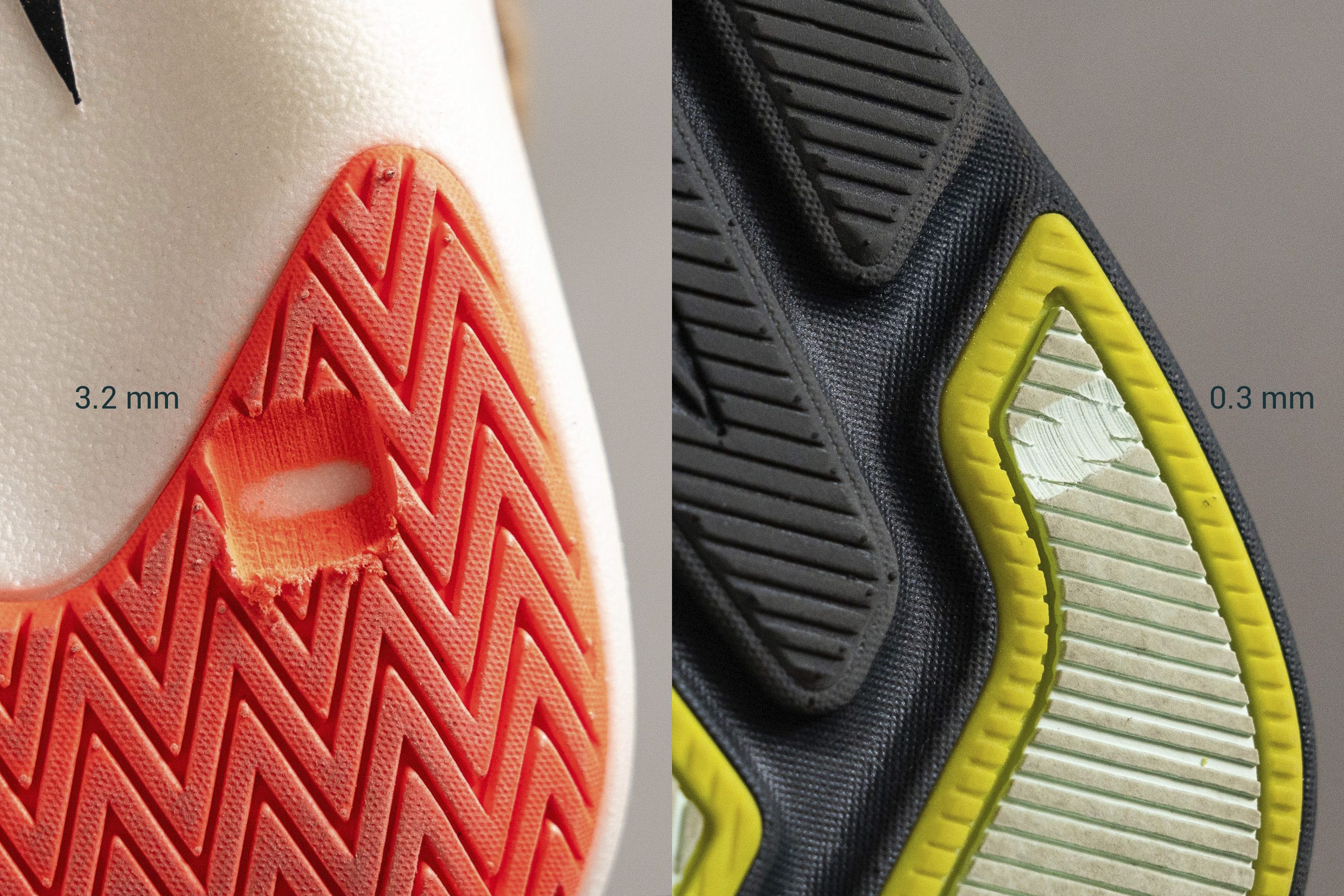
The deeper the dent, the less durable the outsole, of course.

